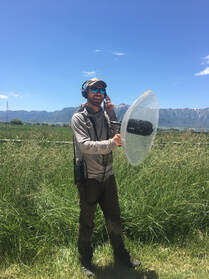Some information may be outdated.
It’s common to remark on the healing power of music, but could song help save an entire subspecies? That’s exactly what biologist Sean Mahoney helped accomplish by arguing the unique songs of southwestern willow flycatchers merited inclusion under the Endangered Species Act. This week, we discuss these desert birds and what makes their songs so special.
Science Moab: What are willow flycatchers known for? Where can we find them?
Mahoney: Willow flycatchers are famous for being very difficult to identify in the field by sight. They’re gray and green, kind of drab-looking with some yellowish coloration. If you talk to a birder, they’ll often talk about how challenging it is to identify these birds. So oftentimes, people are hoping the birds will sing, because flycatchers have very distinct songs.
Flycatchers are “riparian obligates,” so they nest exclusively along rivers. On the Colorado Plateau, they are pretty common along the Virgin River, particularly around St. George. We think that the rivers in Moab are a really important stopover habitat for them.
Science Moab: What are some of the reasons willow flycatchers sing?
Mahoney: In general, birds sing for two main reasons. First, they’re trying to attract a mate. The second reason we think that birds sing is they’re trying to defend a territory.
Science Moab: How is the way willow flycatchers communicate different from other birds?
Mahoney: There’s actually been a lot of similar work that studies birds who learn their song; even in a small geographic area, there can be different dialects simply because the birds learn the song a little bit differently. Those can be really important for making decisions, and can cause populations to diverge.
This is an interesting study, because it uses birds that don’t learn their song. In willow flycatchers, song is not a learned trait; it’s innate. If you raise a nestling willow flycatcher in isolation, it’ll develop its song. There’s something ingrained in its DNA about song.
There are so many other birds that not only have complex songs but also really complex plumage patterns. It’s like those types of birds are using song and plumage to identify potential mates or identify members of their species. But it’s really interesting that willow flycatchers seem to only need song to do so; they’re really just listening to identify their species or potential mates.
A 2015 paper challenged the subspecies status of the endangered southwestern willow flycatcher, arguing that the birds were no different from the other subspecies. Because of that paper, the southwestern willow flycatcher was no longer eligible for protection under the Endangered Species Act. I started studying willow flycatchers after this paper and challenged its findings.
Science Moab: How did your research respond to this 2015 paper?
Mahoney: We argued that because song is ingrained in the southwestern willow flycatcher’s DNA, the subspecies has these unique alleles that cause it to sing a different type of song than the other three subspecies of willow flycatchers. The whole idea of the Endangered Species Act is to conserve genetic diversity, and this was another argument that this group of birds has a unique genetic makeup, and because of that, warrants protection under the Endangered Species Act.
We also found that the birds recognized their own subspecies song. The takeaway is that song is an important signal in identifying subspecies, and that individual birds can recognize those song differences.
Our response paper, we’re proud to say, helped decide that the southwestern willow flycatcher would remain on the endangered species list. We were very, very proud of that work. But when we finished that project, we realized that unfortunately, these sorts of attacks on endangered species throughout the United States are going to continue. We really wanted to get ahead and strengthen as best we could the argument for protection of southwestern populations.
Science Moab is a nonprofit dedicated to engaging community members and visitors with the science happening in Southeast Utah and the Colorado Plateau. To learn more and listen to the rest of Sean Mahoney’s interview, visit www.sciencemoab.org/radio. This interview has been edited for clarity.
Appreciate the coverage? Help keep local news alive.
Chip in to support the Moab Sun News.





